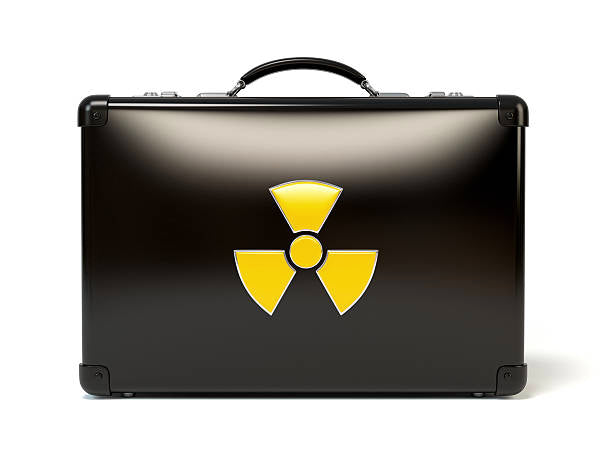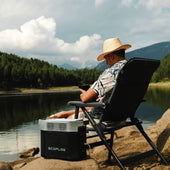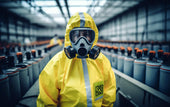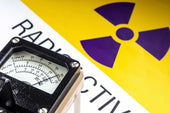Many myths and rumors have circulated concerning suitcase nukes and non-state actors' potential to construct Improvised Nuclear Devices.
Throughout the Cold War, members of Congress expressed alarm about suitcase nukes, which captured the attention of Hollywood and spy television series.
The idea that a nuclear weapon with such devastating power could fit in a suitcase has given rise to an irrational fear of the word, increasing the fear of nuclear mutually assured destruction.
However, the likelihood of danger or improper use of these devices is substantially lower than Hollywood suggests.
What are tactical nuclear weapons?
Small nuclear warheads and delivery systems, known as tactical nuclear weapons, are designed for limited strikes or employment on the battlefield.
They are made to eliminate enemy targets in a particular location without generating significant radioactive fallout.
The smallest tactical nuclear weapons can yield no more than one kiloton, equal to 1,000 tonnes of the explosive TNT. The biggest ones have a maximum mass of 100 kilotons.
Up to 1,000 kilotons in size, strategic nuclear bombs are launched from farther out.
In contrast, the US dropped a 15-kiloton atomic bomb on Hiroshima in 1945.

History
In the 1950s and 1960s, the United States developed the first portable nuclear weapon in the shape of a sizable backpack known as a Special Atomic Demolition Munition. The damage is potent and disturbing for such a small gadget.
The primary purpose of these devices was to be transported by a valiant two-man crew to a specific demolition target, like a dam, tunnel, or bridge. In addition, the resulting radiation served as a tactical denial zone. Some of these weapons could match the Hiroshima bomb's level of devastation.
Although military and special forces have used them for nearly 25 years, they have never been detonated due to the collateral damage they could cause and the exorbitant maintenance costs.
Suitcase Nukes
The "suitcase bomb," a Russian nuclear weapon that the public had no idea existed, came to light in 1997.
One of these transportable nuclear weapons has a one-kiloton explosive charge equal to 1,000 tons of TNT.
A similar weapon could destroy anything within a half-mile of the Capitol in Washington, D.C., and the nuclear fallout would quickly spread throughout the city thanks to the prevailing winds. I-131, a radioactive isotope, would travel for kilometers downwind. One particular personal radiation detector can recognize I-131's beta and gamma radiation.
A "backpack" bomb is yet another transportable weapon. Three "coffee can-sized" aluminum canisters in a sack make up the Soviet nuclear backpack system, which was developed in the 1960s for deployment against NATO targets during a war.
To detonate, all three must be combined into a single unit: the detonator, which is about 6 inches long. Depending on how effectively the explosion occurs, its yield ranges from 3 to 5 kilotons. A battery line attached to the canisters powers it while it is in storage.
If such devices existed, one could infer from the data that they most likely had the following features:
-
Small in size (60x40x20 cm) and light in weight (likely above 30 kg). Both the US SADM and the information now available on Soviet 152-mm artillery projectiles are substantially compatible with these parameters.[19]
-
Low yield, possibly as low as 0.1 kt (less than 1 kt).
-
They were housed at or close to MOD Special Forces (Spetsnaz) sites and central storage facilities and were designed for quick transfer to Spetsnaz. They remained under the jurisdiction of the 12th GUMO (the Main Department at MOD responsible for handling all nuclear weapons).
-
A short maintenance interval between replacements. According to Igor Valynkin, the chief of the 12th GUMO, small munitions required component replacement every few months (other sources suggested six months). Valynkin's remark most directly confirms the claims regarding the existence of portable nuclear devices. It just made no sense to have stationary nuclear mines with such a short warranty life while still being able to utilize portable devices behind enemy lines.
-
They were most likely outfitted with permissive action links or PALs, which should prevent illegal usage, which was probably relatively advanced. Additionally, there is unsubstantiated information that some minor nuclear weapons (such as ammunition for 152-mm howitzers) were retained in a "half-assembled" state during peacetime, meaning that parts were kept apart, even though speedy assembly in the event of war was possible.
Reality Of The Portable Mini Nuclear Bomb Devices

A suitcase nuke or suitcase bomb is a small and lightweight nuclear weapon that might measure 60 x 40 x 20 cm (24 x 16 x 8 inches).
Under normal circumstances, a single critical mass of plutonium (or U-233) at maximal density would be the smallest feasible bomb-like device.
The Pu-239 is 10.1 cm wide and weighs 10.5 kg. Its critical mass is needed to set off large explosions weighing between 10 and 20 tons. These weapons also come in sizes up to two footlockers.
A tube containing two chunks of uranium that, when forced together, would explode serves as the warhead of a suitcase nuclear weapon or bomb. The "suitcase" may include a firing unit and a mechanism that requires decoding to set off an explosion.
Operation
The main application for portable nuclear weapons is their potential to be transported across borders covertly by undercover groups or persons using common and established civilian infrastructure. This minimizes the space between the target and the device without raising red flags.
Their physical limits compromise these nuclear weapons' portability due to their small size.
Every device needs a specific quantity of fissile material to reach critical mass, which is necessary for a spontaneous nuclear chain reaction.
The smallest device created to date weighed less than 100 pounds and exploded with less than 0.2 kilotons of energy.
Current Risk
The logistics of the bombs themselves require a sizable financial and technological infrastructure to produce and maintain, which is why these suitcase bombs have not been widely used in the contemporary war on terrorism.
First of all, plutonium would need to be the primary component of any portable nuclear weapon that was to be tiny enough to be carried by a single person.
A nuclear detonation would require 130 pounds of uranium or around 22 pounds of plutonium. Both would require explosives to cause the blast, but the uranium would require far more.
Due to the difficulty and cost of producing and maintaining plutonium, a hostile group could only produce one by stealing 130 pounds of uranium and building the device without the fissile material frying the circuitry.
These tasks are nearly impossible for most non-state actors and deliver the finished product.
Nuclear device miniaturization continues to pose a risk and danger to all countries.
This antiquated cold-war threat is still a severe reality despite the complicated logistics needed to support the manufacturing and maintenance of a handheld nuclear device due to how undetectably simple it is to get past almost all forms of security as well as the looming threat of more than 100 unaccounted-for Russian suitcase bombs.
Effects

Nuclear devices come in many shapes and sizes, from a small, personal device carried by a person to a warhead carried by a missile. With or without prior notice, a nuclear explosion could happen. Below are its effects on humans:
External radiation
When a person is exposed to radiation from an external source, such as when they are standing close to the location where a radiological device, like a suitcase bomb or suitcase nuke, is set off, they may be exposed to radiation that is either absorbed by their body or that completely passes through it. This is known as external radiation.
Contamination
Contamination occurs when radioactive substances, whether solids, liquids, or gases, are released into the environment and contaminate individuals internally or externally. It can occur when the skin becomes contaminated or the toxic substance enters the body through wounds, the gut, or the lungs.
Incorporation of radioactive material
When bodily tissues, cells, and organs, such as the thyroid, liver, or kidney, are polluted, radioactive material is incorporated into them.
Gamma radiation
Gamma radiation poses a significant external concern because it can penetrate human tissue many centimeters deep and many meters deep in the air. Dense material is required as a shield. Although clothing and some protection can help, beta radiation can travel meters in the air and modestly penetrate human flesh. Although alpha radiation can't penetrate the skin and only travels a short distance through the air, it can still be dangerous if inhaled, eaten, or absorbed through open wounds.
Symptoms
People in the immediate area of a suitcase bomb or suitcase nuke explosion would most certainly die due to the force of the conventional explosion.
Radiation poisoning could cause some bomb survivors to pass away in the weeks that follow. In the days and weeks following the explosion, further away, people could have radiation illness, but they would recover. The likelihood of cancer would only slightly increase over time in the affected area.
To assess the severity of exposure, various physical symptoms must be considered. If the body has suffered from burns or other physical harm, the effects of radiation poisoning also shift. Comprehensive medical care for curable individuals may require more than two months following exposure.
Some signs and symptoms may include nausea, headache, weakness, exhaustion, diarrhea, skin conditions resembling thermal burns, secondary infections, recurrent bleeding, and hair loss.
Treatment
If the external radioactive material is discovered and decontaminated quickly after exposure, about 95% of it can be eliminated by removing the victim's clothing and shoes and washing them in water. Bleaches or other mild abrasives may be needed for further disinfection.
Depending on the types of radioactive isotopes to which the victim was exposed, treatment must begin within the first six to two months after exposure.
Victims will receive shock and bleeding treatment from medical personnel. Open wounds are typically irrigated to remove any radioactive remnants.
If a wound is extremely polluted and functional recovery is unlikely, amputation of limbs may be necessary.
The ingestion of radioactive material is treated to reduce absorption and increase excretion and elimination. Treatment may also involve giving the victim laxatives or aluminum antacids, among other things, or pumping their stomachs.
Treatment may involve administering blocking and diluting medications, such as potassium iodide, to the patient to lessen absorption if radioactive material has entered the victim's interior organs and tissues.
Mobilizing medications, such as ammonium chloride, diuretics, expectorants, and inhalants, are administered to the patient to get the tissues to release the dangerous isotopes. Chelating compounds are also used in other treatments.
When ingested, these substances interact more strongly with some metals than others, forming a stable complex that, when soluble, is eliminated more readily through the kidneys.
Are Suitcase Nukes Real?
The open-source information on suitcase nukes is unclear and lacking.
Even so, one can evaluate the nature of these weapons, the likelihood that an undetermined number of them have been taken, and the gravity of the threat they pose.
Above all, it is crucial to enhance efforts to gather more information about suitcase nukes, including the types of small weapons and their status (whether any were lost and the safety and security measures applied to those still in custody), as well as the potential functionality of those that may have been stolen and hidden for an extended period.





















































